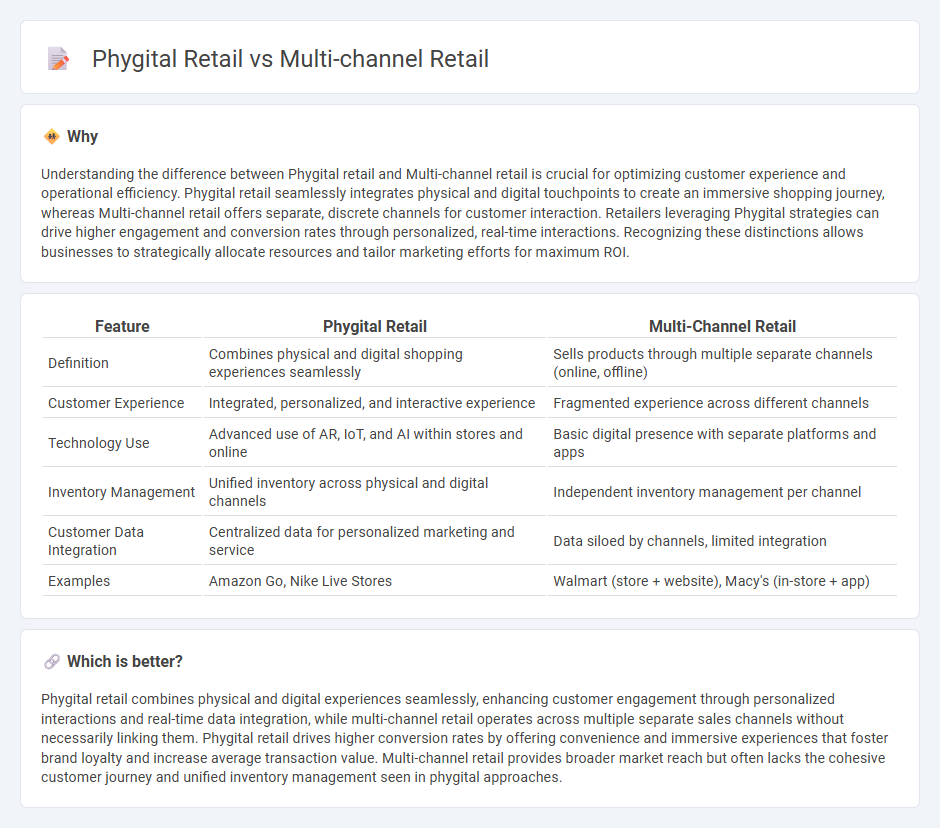
Phygital retail seamlessly integrates physical store experiences with digital technology to create an immersive shopping journey, leveraging in-store digital tools and online platforms for real-time personalization. Multi-channel retail operates through separate, parallel sales channels such as physical stores, websites, and mobile apps, focusing on providing multiple purchasing options without necessarily connecting them. Explore how these strategies redefine consumer engagement and drive retail innovation.
Why it is important
Understanding the difference between Phygital retail and Multi-channel retail is crucial for optimizing customer experience and operational efficiency. Phygital retail seamlessly integrates physical and digital touchpoints to create an immersive shopping journey, whereas Multi-channel retail offers separate, discrete channels for customer interaction. Retailers leveraging Phygital strategies can drive higher engagement and conversion rates through personalized, real-time interactions. Recognizing these distinctions allows businesses to strategically allocate resources and tailor marketing efforts for maximum ROI.
Comparison Table
| Feature | Phygital Retail | Multi-Channel Retail |
|---|---|---|
| Definition | Combines physical and digital shopping experiences seamlessly | Sells products through multiple separate channels (online, offline) |
| Customer Experience | Integrated, personalized, and interactive experience | Fragmented experience across different channels |
| Technology Use | Advanced use of AR, IoT, and AI within stores and online | Basic digital presence with separate platforms and apps |
| Inventory Management | Unified inventory across physical and digital channels | Independent inventory management per channel |
| Customer Data Integration | Centralized data for personalized marketing and service | Data siloed by channels, limited integration |
| Examples | Amazon Go, Nike Live Stores | Walmart (store + website), Macy's (in-store + app) |
Which is better?
Phygital retail combines physical and digital experiences seamlessly, enhancing customer engagement through personalized interactions and real-time data integration, while multi-channel retail operates across multiple separate sales channels without necessarily linking them. Phygital retail drives higher conversion rates by offering convenience and immersive experiences that foster brand loyalty and increase average transaction value. Multi-channel retail provides broader market reach but often lacks the cohesive customer journey and unified inventory management seen in phygital approaches.
Connection
Phygital retail integrates physical and digital shopping experiences to create seamless customer interactions, leveraging technologies like AR, IoT, and mobile apps within stores. Multi-channel retail expands brand presence across various platforms, including in-store, online, and mobile, ensuring consumers can shop through their preferred channels. Both concepts intersect by enabling retailers to deliver consistent, personalized experiences while capturing data across touchpoints to optimize inventory management and marketing strategies.
Key Terms
Channel Integration
Multi-channel retail operates through separate online and offline channels, often lacking seamless integration between touchpoints, which can create fragmented customer experiences. Phygital retail merges physical and digital channels into a cohesive ecosystem, ensuring real-time synchronization of inventory, personalized marketing, and unified customer data for improved engagement. Explore the advantages of phygital retail channel integration to enhance customer satisfaction and operational efficiency.
Customer Experience
Multi-channel retail integrates various platforms like physical stores, online shops, and mobile apps, providing customers with multiple purchasing options but often operating in silos. Phygital retail merges physical and digital experiences seamlessly, using technologies like augmented reality, smart mirrors, and personalized mobile interactions to enhance engagement and convenience. Explore how phygital strategies can transform customer experience and drive loyalty in competitive markets.
Technology Adoption
Multi-channel retail integrates various sales platforms such as online stores, mobile apps, and physical outlets to enhance customer reach and convenience through seamless technology adoption. Phygital retail combines physical and digital experiences within the same environment, utilizing technologies like augmented reality, IoT sensors, and AI-driven analytics to personalize and enrich the shopping journey. Explore deeper insights into how emerging technologies are reshaping retail paradigms and boosting consumer engagement.
Source and External Links
Multichannel Retailing: Decide on Sales Channels for Your Business - Multichannel retailing is a strategy of selling products via multiple online and offline channels such as ecommerce sites, physical stores, and social media, allowing customers to buy where they prefer and boosting sales by providing choice and flexibility.
What is Multi Channel Retailing: Definition - Informatica - Multi-channel retailing increases customer contact points and aims to offer a consistent, integrated shopping experience across diverse channels, improving customer loyalty and reducing purchase barriers, though it faces challenges like data coordination among independent sales systems.
What Is Multichannel Retailing? (With Definition and Tips) - Indeed - Multichannel retailing involves operating multiple sales channels that function independently to reach new customers and provide product access via different platforms, distinct from omnichannel retailing which integrates channels for a unified customer experience.
 dowidth.com
dowidth.com